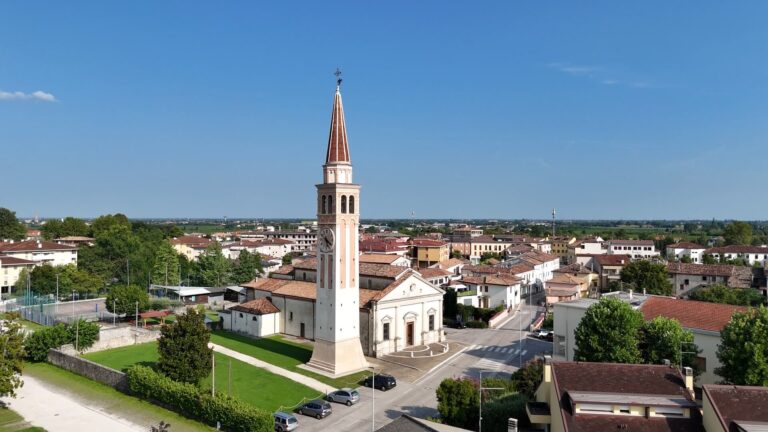ARTISTS’ ROADS
LE VIE DEGLI ARTISTI
watch the videos at the bottom of the page!
SUSEGANA
A Masterpiece To Proclaim The Sacred: Pordenone in Susegana
The sky is a deep, vivid blue. Billowing cumulus clouds bathed in light. A patch of flower-strewn grass.
Nature bursts into this scene. It welcomes and enfolds a solemn event: The Madonna, her Child, and four saints, caught in the midst of a sacred conversation beneath the open sky.
And if we look closely, nature has already begun to reclaim the work of man. On the semicircular architecture in the background, lush shrubs are taking root.
The materials themselves offer tactile sensations. We can feel the coldness of the stone, where it forms buildings, paving, or the steps of the throne. And the warmth of the wood, in the severed branch crafted by John the Baptist into a processional cross, in the broken wheel held by Catherine of Alexandria. And again, in the lute the angel is tuning to bring music to the gathering.
The four saints stand like living pillars. Their bodies are wrapped in sumptuous, vibrant fabrics. Their faces are strongly defined. Their feet firmly planted.
John the Baptist is mirrored by Peter. Catherine by the prophet Daniel.
Daniel is a key figure. The oldest among them. A lion sits at his side, recalling the den where he was imprisoned by Darius, king of the Persians. Through divine inspiration, five centuries before Christ’s incarnation, Daniel had foreseen its revolutionary power: Out of the ruins of a fallen world, the Church would rise, radiant. This is symbolised by the monumental colonnade, to be read from right to left, from shadow to light, beginning with Daniel’s raised finger and ending with the Baptist’s, directing our gaze towards the Virgin and her Child.
Jesus kicks playfully in Mary’s arms, grasping her veil with his tiny left hand. Mother and Son both have auburn hair and pearlescent skin. The liveliness of the Child contrasts with Mary’s wistful gaze, as she keeps this great mystery hidden in her heart.
A parchment bears the artist’s signature: Giovanni Antonio de’ Sacchis, known as Pordenone.
When he paints this altarpiece, probably around 1514, He is already a great master. A bridge between Venice, Friuli, and Central Italy. Between the legacy of Giorgione and the genius of Michelangelo and Raphael. Combining powerful colour with anatomical force. A brilliant orchestrator of space, filled with crowds of figures, Pordenone may have grown up in a provincial setting, but his talent brings him prestigious commissions: from Umbria to Lombardy, from Emilia to Liguria, in dialogue with a host of artistic languages.
In Susegana, he is commissioned by the Counts of Collalto, undisputed lords of these lands, eager to celebrate their presence through works of great artistic value.
Pordenone is already frescoing the church at nearby Castello di San Salvatore for them, with his unmistakable creative fervour.
This altarpiece for the high altar completes the renovation and adornment of the ancient parish church of Santa Maria. The project falls to the Collalto family, who at that time hold the patronage rights over the church.
And the bond with the noble family marks the painting deeply. The two saints on the left evoke Giovanni Battista I of Collalto and his wife Caterina Trissino, parents of Giovanni Antonio, likely the patron of this work.
MORE EXPERIENCES!
I dipinti su tavola:
- Il Pordenone a Moriago
- Francesco da Milano a Lago
- Il Cima a Conegliano
- Francesco da Milano nella parrocchiale di Anzano
MULTIMEDIAL MAP: “ARTISTS’ ROADS – LE VIE DEGLI ARTISTI- EN”!

